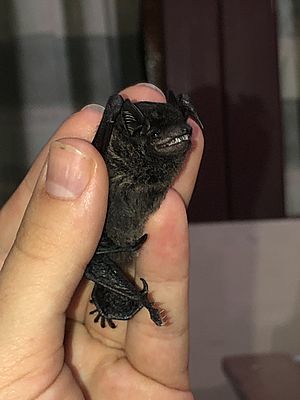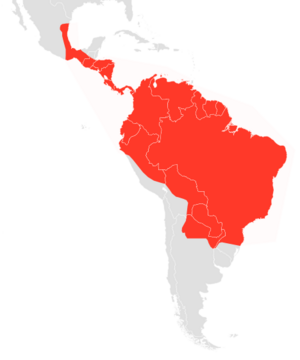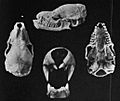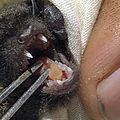Black myotis facts for kids
Quick facts for kids Black myotis |
|
|---|---|
 |
|
| Conservation status | |
| Scientific classification | |
| Genus: |
Myotis
|
| Species: |
nigricans
|
 |
|
| Black Myotis range | |
The black myotis (Myotis nigricans) is a small bat found in parts of South America and Central America. It's a type of vesper bat, known for its dark brown or black fur. This tiny bat is about 5 cm (2 inches) long, not counting its tail. It has a small, pointed snout and very sensitive, triangular ears. Its wings are like forearms with one claw, while its back feet have five claws. Its body is covered in short hair.
Contents
Where Do Black Myotis Bats Live?
The Myotis group has over 100 different species worldwide, except in Antarctica. The black myotis specifically lives in southern Mexico (like Veracruz, Oaxaca, and Chiapas) all the way down to Peru, Bolivia, northern Argentina, Paraguay, southern Brazil, Trinidad and Tobago, and some Lesser Antilles islands (St. Martin, Montserrat, and Grenada).
These bats often make their homes in places like tree bark, thick leaves, or even on the ceilings of buildings and houses. Black myotis bats can live peacefully with other bat species from their own group. They sometimes share food and sleeping spots. However, they might compete for food and roosts with other bats that also eat insects.
Life Cycle of a Black Myotis Bat
A baby black myotis bat grows inside its mother for about 60 days. For the first two or three days after birth, the young bat stays very close to its mother. After this, mothers will leave their babies in groups at the roost (their home) at night to go hunting for food. When they come back, mothers use their amazing sense of smell and hearing to find their own babies.
By the time they are two weeks old, young bats have already reached their adult weight! They start learning to fly at three weeks old. It takes them one to two weeks to become really good at flying. Baby bats stop drinking their mother's milk when they are about five or six weeks old. This usually happens in April, during the wet season, when there are lots of insects to eat. After they are weaned, the grown-up bat will leave the roost where it was born. Some black myotis bats have been known to live for up to 7 years.
How Black Myotis Bats Behave
Studies show that black myotis bats are very good at finding their way home. They can recognize an area up to 13 km (about 8 miles) around their roost. Some bats that were moved 50 km (about 31 miles) away were able to find their way back within just two days!
When the weather is good, these bats leave their roost about an hour after the sun sets. They return from hunting about an hour before the sun rises.
A bat's body temperature can change depending on how warm or cool it is outside. If their body gets too cool, bats can enter a special state called torpor. This is like a deep sleep where they save energy. They stay in this state until their body warms up again. To cool down, they spread out in their roost into smaller groups. This helps them release body heat.
What Black Myotis Bats Eat and Who Eats Them
The black myotis mainly eats insects. There have been a few times when they were seen eating fruit, but this is rare. Young bats face many dangers, like being eaten by predators, getting sick, or having parasites.
Some animals that hunt and eat black myotis bats include opossums, cats, and even other types of bats. Snakes, cockroaches, and spiders can also be predators. Young bats also have to deal with tiny creatures called ectoparasites. These include mites, bat mites, soft ticks, hard ticks, chigger mites, fleas, and bat flies, which live on the outside of their bodies.
Gallery
See also
 In Spanish: Murciélago negro pequeño para niños
In Spanish: Murciélago negro pequeño para niños






